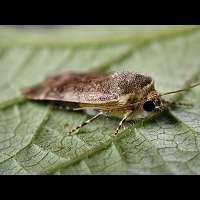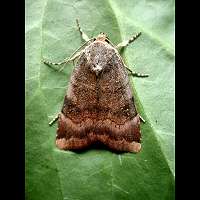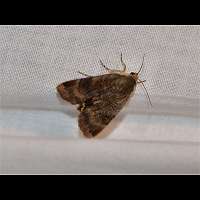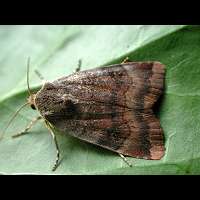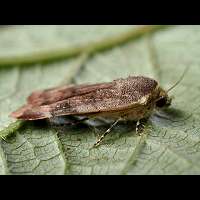Lesser Broad-bordered Yellow Underwing Noctua janthe
This species is unmistakable. Both upperwing and underwing are quite unique, supposing Langmaid's Yellow Underwing is not present in Britain. For up to 1991 the Lesser Broad-bordered Yellow Underwing and Langmaid's were considered to be one and the same species. The presence of Langmaid's in Britain remains uncertain. The Lesser Broad-bordered Yellow Underwing reaches a wingspan of 34 to 44 mm.
The eggs are being laid in July and August, but they hatch in September. The larvae feed at night and rest during the day, usually close to the ground. In this stage they are usually found on low-growing herbaceous plants. The half-grown caterpillar overwinters just above the ground. In early spring they start eating again. Many remain on fresh plants near the ground, but quite a large number now moves into trees and shrubs. By the end of April they all go to the ground again and dig a little hole, in which they pupate in a light cocoon. The caterpillars of the Lesser Broad-bordered Yellow Underwing are brown and have a faint yellowish white dorsal line. Furthermore there are arrow shaped markings on the back. These are most pronounced on the segments 10 and 11. They have a brown head. The larvae grow to a length of 37 to 40 mm. From summer to winter we find them in all kind of low growing herbaceous plants. In spring they can still be found there, but in trees (birches) and bushes (bramble, blackthorn) as well.
The Lesser Broad-bordered Yellow Underwing mainly flies about in July and August. They are on the wing not only during the night, but in broad daylight as well. May even feed on garden flowers in bright sunshine. The animal is attracted to both light and sugar. A very common species all over Europe, including all of Britain.
This species is unmistakable. Both upperwing and underwing are quite unique, supposing Langmaid's Yellow Underwing is not present in Britain. For up to 1991 the Lesser Broad-bordered Yellow Underwing and Langmaid's were considered to be one and the same species. The presence of Langmaid's in Britain remains uncertain. The Lesser Broad-bordered Yellow Underwing reaches a wingspan of 34 to 44 mm.
The eggs are being laid in July and August, but they hatch in September. The larvae feed at night and rest during the day, usually close to the ground. In this stage they are usually found on low-growing herbaceous plants. The half-grown caterpillar overwinters just above the ground. In early spring they start eating again. Many remain on fresh plants near the ground, but quite a large number now moves into trees and shrubs. By the end of April they all go to the ground again and dig a little hole, in which they pupate in a light cocoon. The caterpillars of the Lesser Broad-bordered Yellow Underwing are brown and have a faint yellowish white dorsal line. Furthermore there are arrow shaped markings on the back. These are most pronounced on the segments 10 and 11. They have a brown head. The larvae grow to a length of 37 to 40 mm. From summer to winter we find them in all kind of low growing herbaceous plants. In spring they can still be found there, but in trees (birches) and bushes (bramble, blackthorn) as well.
The Lesser Broad-bordered Yellow Underwing mainly flies about in July and August. They are on the wing not only during the night, but in broad daylight as well. May even feed on garden flowers in bright sunshine. The animal is attracted to both light and sugar. A very common species all over Europe, including all of Britain.

